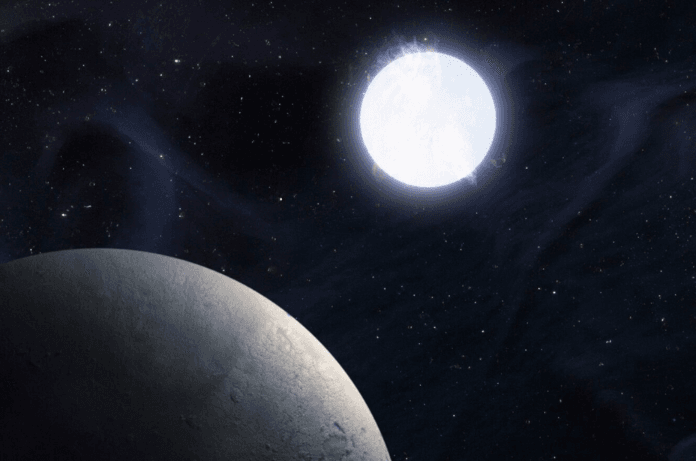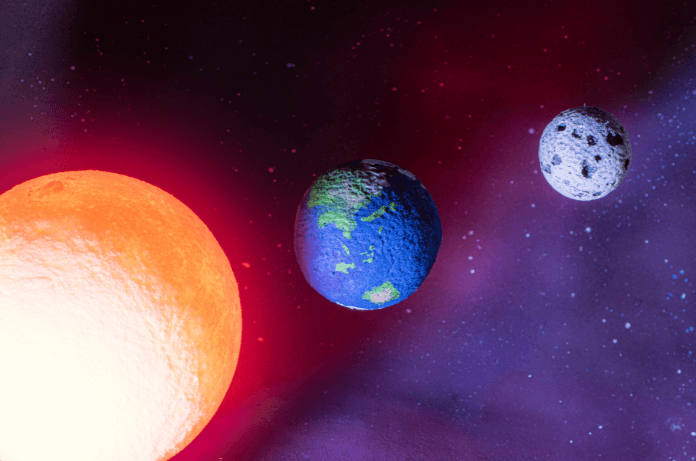Have you ever wondered what Earth might look like billions of years from now? It’s a question that fascinates both scientists and sci-fi fans. Now, astronomers might have found a planet that gives us a glimpse of Earth’s far-off future. This planet, named KMT-2020-BLG-0414, is located 4,000 light-years away from Earth and could show us what might happen to our planet when the Sun reaches the end of its life.
This discovery is more than just a cool space find it could be a hint of Earth’s distant future. The planet orbits a dead star, known as a white dwarf, which is what our Sun will eventually turn into. So, what exactly did astronomers find, and why is it important to us? Let’s break it down.
The Future of the Sun and Earth’s Fate
Just like every star, our Sun has a life cycle. Right now, it’s in the middle of its life, about 4.6 billion years old. In around 5 billion years, the Sun will start to run out of fuel and will expand into a massive red giant. As it grows, it could swallow planets like Mercury, Venus, and maybe even Earth. After this, the Sun will lose its outer layers and shrink into a small, dim white dwarf.
The planet KMT-2020-BLG-0414 is already orbiting a white dwarf, and this gives us a peek into what might happen to Earth when the Sun dies. The big question is- will Earth survive the Sun’s transformation into a red giant? The discovery of KMT-2020-BLG-0414 suggests it’s possible.
A ‘Future Earth’?
What makes KMT-2020-BLG-0414 special is that it survived the death of its star. Even after its star expanded and became a red giant, the planet stayed in orbit when the star turned into a white dwarf. This could mean that Earth, billions of years from now, might still exist and orbit what’s left of our Sun after it dies.
Scientists aren’t sure what this distant planet is made of, but some think it might be a rocky planet like Earth. If that’s true, this discovery shows that some planets can survive when their stars die and continue to orbit in very different environments.
“We do not currently have a consensus whether Earth could avoid being engulfed by the red giant sun in 6 billion years,” said study leader Keming Zhang, a former doctoral student at the University of California, Berkeley
How Astronomers Found KMT-2020-BLG-0414
Finding a planet 4,000 light-years away is not easy. Astronomers used a special method called gravitational microlensing to detect it. Here’s how it works: when a star (or a white dwarf) passes in front of another distant star, the white dwarf’s gravity bends the light of the distant star. This creates a sort of “magnifying glass” effect, which helps astronomers spot planets that are otherwise too far to see.
In the case of KMT-2020-BLG-0414, astronomers noticed this effect as the white dwarf passed in front of another star, revealing the presence of the planet. This method is one of the few ways to find planets around very faint stars like white dwarfs.
Will Earth Have the Same Future?
It’s mind-blowing to think that Earth might someday orbit a white dwarf like KMT-2020-BLG-0414. When the Sun becomes a red giant, Earth’s oceans will evaporate, its atmosphere will disappear, and life as we know it will be long gone. But could the planet itself survive? Scientists are still debating this. Some believe Earth could be swallowed by the Sun as it expands. Others think it might escape destruction, just like KMT-2020-BLG-0414.

Even if Earth survives, it would be a very different place. It would orbit a dim, dying star, and any life forms would need to exist in extreme conditions or there might be no life left at all.
What Does This Discovery Teach Us?
The discovery of KMT-2020-BLG-0414 is exciting because it shows that planets can survive the death of their stars. This gives scientists a chance to study the future of planets and solar systems like our own. Right now, astronomers don’t know how many planets survive when their stars die, but this discovery shows it’s possible.
This also helps us understand how planets and stars interact. Scientists have long wondered what happens to planets when their stars die. Do they get destroyed? Do they stay in orbit? KMT-2020-BLG-0414 gives us hope that some planets can make it through.
Why Should We Care?
You must be thinking, “Why should I care about a planet 4,000 light-years away that won’t affect Earth for billions of years?” It’s true that none of us will be there to see Earth’s future billions of years from today. But discoveries like this help scientists learn more about how stars and planets evolve over time. The more we know about distant planets and solar systems, the better we understand our own place in the universe.
This also reminds us that everything in the universe, including our Sun and Earth, has a lifespan. Stars are born, they live, and they die. Planets form, change, and eventually meet their own end. Even though 8 billion years sounds like a long time, in cosmic terms, it’s just a blink.
Could Life Exist on Planets Orbiting White Dwarfs?
Another interesting question is whether life could exist on planets like KMT-2020-BLG-0414. After a star dies, the conditions are harsh and there’s little heat, no sunlight, and lots of radiation. But could life find a way to adapt to these extreme conditions? Some scientists think it’s possible.
In fact, astronomers are already looking for signs of life on planets orbiting white dwarfs using powerful telescopes like the James Webb Space Telescope. By studying planets like KMT-2020-BLG-0414, we can learn more about whether life could survive in such a tough environment.
A Glimpse Into Earth’s Future
The discovery of KMT-2020-BLG-0414 offers an exciting glimpse into what might happen to Earth billions of years from now. It shows that planets can survive even when their stars die, and it raises important questions about life beyond Earth. While we won’t be around to see it, discoveries like this help us understand the bigger picture of the universe.
So, the story of KMT-2020-BLG-0414 is a reminder of how vast and mysterious the cosmos is. Earth may seem small, but by studying distant planets and stars, we learn more about our own future and place in the universe. And who knows? Billions of years from now, Earth might still be orbiting the remains of our Sun, a lonely survivor in a transformed solar system.

